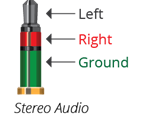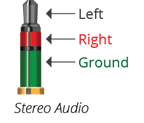Below are detailed descriptions of the auxiliary in and auxiliary out jacks and information about using them.
Auxiliary input (In) jack
The 3.5mm stereo jack input connection is a single-ended, unbalanced signal and has a maximum input signal of 1 Vrms (2.83 Vp-p). The signal provided to this input needs to be checked for compatibility.
Any equipment providing voltages above this level (e.g. speaker levels) may result in clipping distortion and, in extreme cases, damage to the HDL410 system. Equipment providing voltages well below this level (e.g. microphone level vs. line level) will not be adequate to drive the signal and may result in quiet or no audio on the channel. Before connecting to this port, check that the provided voltage levels are adequate or ensure that the levels are adjusted properly by additional interfacing hardware.
As the input is single-ended and therefore unbalanced, make sure the input audio signals provided into the In jack are single-ended. Balanced or differential outputs from the equipment could cause issues and may have to be adjusted with additional interfacing hardware. As the signal and cable are single-ended, the shorter the cable is the less noise will be coupled to the signal, making the audio clearer.
The 3.5mm jack supports a standard TRS (tip-ring-sleeve) jack pinout with the left channel on the tip, the right channel on the ring and the ground on the sleeve (see diagram below). When mono audio is played over this channel, the same audio will be reproduced on both the left and the right channels. If a mono audio TS jack is plugged in, the right channel will be shorted to the ground and only the left channel will be connected.

The HDL410 system speakers will play back sound from the connected source with the input jack. Both the USB and auxiliary jacks can be connected at the same time and may even be used simultaneously. In such a case, the input sources will be combined (between the input jack and USB auxiliary input). Therefore, switching between the input jack and USB is not required. If only the audio is being used from the USB and not the auxiliary jack, the nil input from the auxiliary jack will not impact the audio from the USB (and vice versa). In this configuration, make sure the device connected to the analog input jack will not generate any noise when it is idle, on standby, or off – otherwise it could interfere with the USB audio.
It is also possible for the HDL410 system to interface through the USB with an audio conferencing application and simultaneously connect through the auxiliary jack to an external device with an analog source (such as a DVD player audio). This setup would allow the HDL410 system’s speakers to output either the audio conferencing channel or the DVD audio to the room.
Auxiliary output (Out) jack
The connect module has a 3.5mm stereo output jack. By default, this output connection is a single-ended, unbalanced signal and has a default maximum output signal of 0.92 Vrms (2.6 Vp-p) into a 10Kohm load. Any equipment requiring voltages below these levels (e.g., microphone levels as opposed to line levels) may result in clipping or distortion. In extreme cases, this may damage connected systems. Equipment requiring voltages well above these levels will not be adequately driven by the HDL410 system’s output signal and may result in quiet or no audio on the channel. Before connecting to this port, make sure the provided voltage levels are adequate or double-check that the levels are adjusted properly by additional interfacing hardware.
As the output is single-ended and therefore unbalanced, ensure that the audio signal input of the attached equipment will be acceptable. As the signal and cable are single-ended, the shorter the cable is the less noise will be coupled to the signal, making the audio clearer.
As with the input jack, the 3.5mm output jack supports a standard TRS (tip-ring-sleeve) jack pinout with the left channel on the tip, the right channel on the ring and the ground on the sleeve (see diagram below). If mono audio is played over this channel, the same audio will be reproduced on both the left and the right channels. If a mono audio TS jack is plugged in, the right channel will be shorted to the ground and only the left channel will be connected.

The default signal provided by the output jack is microphone pickup which is echo-canceled. The signal is intended to be connected to equipment that will transmit audio to the far end of the conference site. If the system connected to the HDL410 system also provides echo cancellation or additional processing of the audio signal, there may be some conflict in algorithms and therefore less-than-optimal performance. In this case, disable echo cancellation on the connected system (e.g., directly pass-through audio).
Audio jack cabling
As the signal and cable are single-ended, keeping the cabling length to a maximum of 6 feet to ensure minimum noise is coupled onto the signal. Avoid running noisy cables next to these audio cables so coupling does not occur. Installing the connected equipment next to the connect module will help make sure this happens.